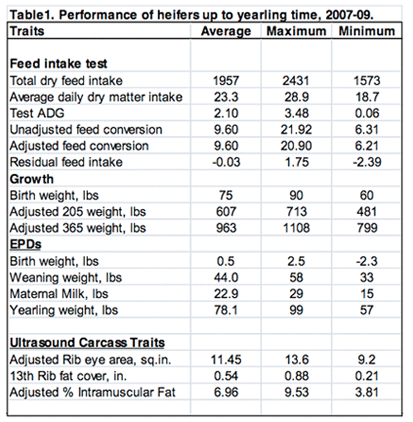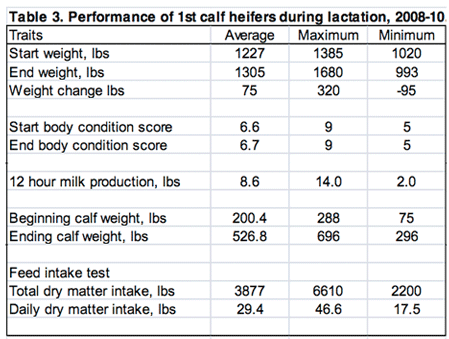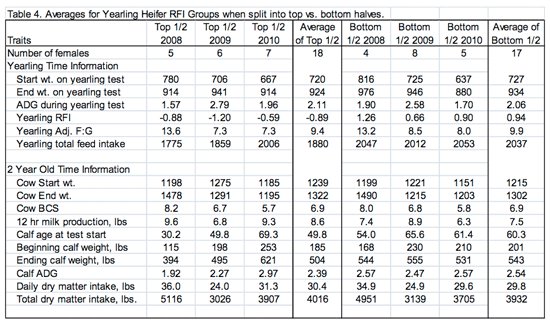



Feed Efficiency In Heifer Development & 1st Lactation
Daryl Strohbehn, Professor Emeritus of Animal Science and Garland Dahlke, Extension Program Specialist, at Iowa Beef Center report on the third year of a study which looks at the relationship between feed efficiency measures during the heifer development stage and measures taken during first lactation in purebred Angus.Summary and Implications
Angus first-calf heifers were evaluated for feed intake utilising the Feed Intake Monitoring System developed at ISU. Average dry matter intake for the feeding period was 3877 pounds with difference in dry matter intakes from the lowest to the highest intake female averaging 2143 lbs over the three years of the study. During the study an average difference between the lowest and highest consuming first- calf heifer was 22.3 lbs daily to 38.4 lb. Feed intake during first year lactations between negative and positive RFI groups appears small after three years of observation; however, complete statistical analysis has not been accomplished at this writing.
Introduction
Feed costs represent about 60 per cent of total costs to maintain a beef cow herd in the US As land continues to escalate in value, a resulting increase occurs in grazing costs, stored feeds and supplementation procedures. Past studies in the feedlot industry show that improvements in feed efficiency reduce costs of production nearly five times more than improvements in growth rate. Current research in the genetics of feed efficiency centers predominantly around growth from weaning to harvest time and fewer projects address the implication of improvements with breeding females. Additionally, no US projects currently involve cattle with a historical background of selection for feed efficiency. This project is meant to address the furthering of knowledge on feed utilization in Angus females following their first calving and subsequent weaning of the calf. The purpose of the current study is to determine if heifers evaluated for feed efficiency during their growth phase from weaning to yearling have similar rankings in feed utilization for continued developmental growth and milk production during the nursing stage with their first calves.
Material and Methods
Cows used in 2008 through 2010 of this three year project were evaluated at Wardens Farm, Council Bluffs, Iowa as yearling heifers for feed intake, gain and resulting feed conversion and residual feed intake during the weaning to yearling development period. This was done using a pelletted ration fed through PinPointer 4000 feed intake systems. The pellet used contained net energy for maintenance and gain of .74 and .46 mcals per pound of dry matter, respectively, with a protein content of 14 per cent. Long stem, predominantly brome grass, hay was offered at 3-4 pounds daily. This was not accounted for in the feed efficiency calculations. At yearling time all heifers were evaluated for carcass traits using certified ultrasound procedures. Heifers were artificially and naturally serviced to one bull, thus reducing calf genetic variation. Average weaning and yearling performance in addition to feed intake and efficiency data is shown in Table 1.
All heifers were calved by Wardens Farm and then transported post-calving to the Iowa State University Beef Nutrition Farm, Ames, Iowa. These first-calf heifers and their calves received Radio Frequency ear IDs which work in concert with the Feed Intake Monitoring System (FIMS) as described in AS Leaflet R R2279, 2008 ISU Animal Industry Report. In addition to the feeding facility barn, the first-calf heifer pairs were managed in two drylot areas adjacent to and with complete access to the FIMS barn. The drylot grass areas measured 181’ x 100’ and 181’ x 80’ for a total of 32,580 square feet. These were closely mowed utilizing a rotary mower to eliminate grass growth so an insignificant amount of grass was available for consumption, yet it provided a cleaner and drier area for sound nursing and calf rearing. All feed fed to the heifers was offered through the FIMS with it serving as a general loafing barn with all gates kept open. Heifer pairs were allowed access to any and all FIMS bunks within six of the seven pens. The seventh pen was used as a loafing area closed off for access only by the calves.
A forage-based ration was fed ad libitum which met NRC requirements for maintenance, heifer growth and milk production levels associated with Angus genetics of this type (see Table 2). All feedstuffs were analyzed utilizing a commercial feed testing laboratory. Heifers and calves were weighed at monthly intervals and during that activity, heifer milk production was measured via the weigh-suckle-weigh technique.
At approximately 60 days post-calving heifers were bred artificially using the Co-Synch+CIDR synchronization system in 2008 and the 5-day CO-Synch+CIDR system in 2009 and 2010 and then exposed to a natural service sire for two estrus cycles or 45 days. Calves were provided with limited dry hay and a creep feed consisting of a soyhull pellet-dry distillers grain mix in the first 2 years of the trial and just dried distillers grain with hay in the third year. Creep intake increased from 1.5 to 8 pounds per calf as calves approached weaning. Weaning took place at an average age of 185 days.


Results and Discussion
Fifteen, 14 and 12 first-calf heifers were transported to the ISU beef nutrition farm in late May of 2008, 2009 and 2010, respectively, and were immediately started on feed in the FIMS system. Starting in late May heifers were monitored for daily feed intake for about 140 days. Early on in the first year trial (day 21) it was determined that ration sorting was occurring, so to alleviate that problem ration reformulation was done to allow a liquid molasses addition to take place (see Table 2). In year two and three corn silage was utilized in the ration and no sorting problems were noticed. Due to ration dryness in year one some cows became habitual in flipping feed from the bunk system and adjustments to their intakes were necessary. Considerable rain fell during the month of June in year one making lot conditions challenging, yet persistent barn cleaning and bedding kept conditions acceptable. However, late in June coccidiosis went through the calves eventually causing the death of one nursing calf and weakening another such that it succumbed to respiratory disease in late August. These problems were prevented in the second and third years by including dequinate in the creep feed and aggressively treating calves intramuscularly with an antibiotic at the first indication of respiratory infection. In year one first-calf heifers gained more than desired in body weight and increased by 1.1 in body condition score during the feeding period for an average of 7.7 (see table 3). However, in year two and three with the significant ration change the heifers had limited weight or condition score change. Milk production as determined by the calf weigh- suckle-weigh procedure averaged 8.6 lbs for a 12 hour period. The nursing calves gained on average 2.47 lbs daily.

Daily feed intakes for individual cows varied a great deal on a day to day basis, but also for the entire feeding period (see table 3). The average daily dry matter intake was 29.4 pounds with a total intake of 3877 pounds for the feeding period. Of interest, of course, is the variation across the herd in total intake and how efficiently these cows convert feed into milk and calf gain. In the initial year there was over a 3100 pound difference in dry matter intakes from the lowest to the highest intake female while in year two and three there were a 1425 lb and 1900 lb difference, respectively, in dry matter intake. Top half RFI yearling heifers were compared to bottom half RFI heifers in Table 4. As seen in the yearling development stage top half RFI heifers gained slightly more on test, but consumed 157 less dry matter than bottom half RFI heifers resulting in feed conversion differences. During their first lactation top half RFI heifers on average consumed 84 lb more dry matter, but there is inconsistency from year to year when year averages are observed. Top half RFI heifers had calves which gained less during the period in both years. It is important to notice at this time top half RFI heifers had calves which started on trial 10.5 days younger and there was a significant calf sex split difference between the two groups favoring the bottom half RFI heifers.



